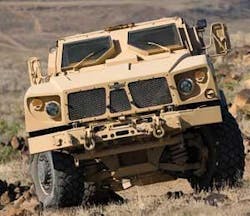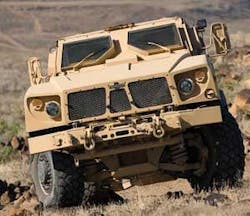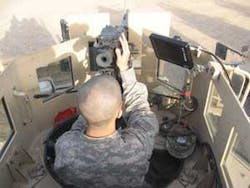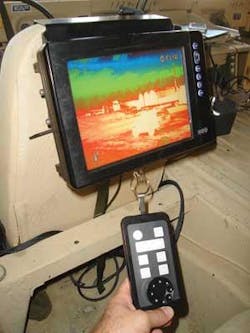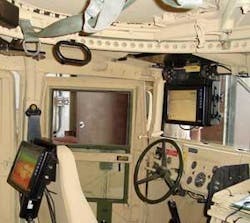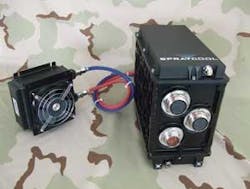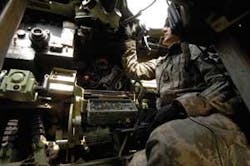Advanced vetronics: hit the ground running
Industry heeds the warfighter’s call for innovative, responsive, and reliable electronics in combat vehicles on the ground.
By Courtney E. Howard
Today’s warfighters require an ever-increasing amount of electronics systems to meet various mission objectives. At the same time, military ground vehicles, the warfighters who operate them, and the onboard vehicle electronics are required to perform missions in demanding, sometimes hostile environments.
Ground combat vehicles integrate myriad complex electronic components, which deliver command, control, and communications; intelligence, surveillance, and reconnaissance; and defensive and offensive weapons systems, as well as operate the vehicles themselves.
When it comes to vehicle electronics, or vetronics, military officials and personnel “want what they’ve always wanted, but more of it,” says Frank Willis, director of mil/aero product management at GE Fanuc Intelligent Platforms in Charlottesville, Va. GE Fanuc vetronics solutions are employed on the M1A2 Abrams main battle tank (MBT), Medium Extended Air Defense Systems (MEADS), NLOS-Cannon (NLOS-C), Expeditionary Fighting Vehicle (EFV), and Multiple Launch Rocket System. “More processing power. More bandwidth. More lightweight. More compact. More interoperability. More rugged. More maintainable. And, of course, more inexpensive.”
SWaP severity
Size, weight, and power (SWaP) present the biggest challenges facing vetronics systems designers and systems integrators. It is increasingly difficult to pack a computing infrastructure, as well as soldiers, into a vehicle platform. At the same time, conditions within the vehicle can be less than ideal for the soldiers who inhabit it. Some combat vehicle environments can be considered inhospitable, or even dangerous.
Ground vehicle platforms are often “cluttered with radios of different types and sizes, computer platforms, intercom systems, sometimes several GPS receivers, and loose wires hanging,” admits Mike Polaneczky, senior C4ISR systems architect, General Dynamics C4 Systems in Scottsdale, Ariz. Gunners often sit in slings between the occupants of the vehicles, who may inadvertently kick out wires as they move around. The soldiers themselves are often bulky, wearing body armor, helmets, night-vision goggles, weapons, radios, and also storing guns, ammo, and water rations within the vehicle.
All of the things we end up putting in the vehicle as an aid can end up becoming a detriment at some point, laments Polaneczky. “It could be a lot better organized.”
To that end, officials at General Dynamics C4 Systems opened the EDGE Innovation Center this month.
“Our focus is on how do we get a lot of the mission-specific functions in today’s vehicles operating much more efficiently from a SWaP perspective,” Polaneczky explains. He and other engineers are investigating ways of consolidating all these different mission functions into a common compute environment, and then linking the computing environment to use information in intelligent ways and to make the interior operating environment much more efficient. “We are innovating to that end, and the soldier is the central focus of everything we do. Those systems need to serve that soldier in an intelligent, efficient manner.”
Cramped quarters
“We are seeing an interest in consolidating computation hardware… to enhance crew space inside vehicles,” mentions
Jim Shaw, vice president of engineering at Crystal Group in Hiawatha, Iowa. “Vehicles have become so cramped and congested with electronics and machinery, it makes lengthy missions difficult and less effective.” The Stryker, he points out, is a classic example of too much equipment in not enough space.
“Rearming the light/heavy Armored Cavalry has become a priority for the Department of Defense (DOD),” Shaw says. “The emphasis on SWaP is not surprising. The ability to make improvements in power and size continues to be the driving pace of technology from the commercial side of the industry. Rugged COTS (commercial off-the-shelf) plays a key role in making space for the warfighter.”
Crystal Group has been developing high-performance computers and processing units based on a distributed architecture using Intel Nehalem CPUs and associated chipsets. “These systems can be more virtualized due to a rapidly growing number of cores available per CPU, as well as the reintroduction of Intel Hyper-Threading technology into the Nehalem platform,” Shaw explains. Additionally, the QuickPath Interconnect (QPI) architecture enables the creation of more virtual cores without being constrained by the classic memory hub controller bottle neck. “It provides more bandwidth and lower latency, especially in virtualization applications. And that means fewer computers on the vehicles, doing more things in less space.”
null
Central computing
“If the vehicle’s main mission computer is the heart of the platform, then the remote interface unit (RIU) serves as the vehicle’s nerve and arterial supply,” says Doug Patterson, vice president of worldwide sales and marketing at Aitech Defense Systems in Chatsworth, Calif. Aitech has provided more than 100 RIUs to the U.S. Army’s Future Combat Systems (FCS) NLOS-C program to date.
“The RIU is connected to the mission computer via dual-redundant, fiber Ethernet and, on command, supplies critical information to major functional analog and digital elements of the vehicle, while collecting and storing mission-critical and vehicle maintenance data for later download to assist with a concept, condition-based maintenance (CBM),” Patterson explains.
CBM employs real-time data to prioritize and optimize maintenance resources. “It is a newer effort spearheaded by the FCS Program Office, but it is certainly applicable to all modern vehicle platforms to provide key maintenance data of subsystem components (engine, transmission, electrical systems control, gun control, etc.) on an as-used basis, rather than a pre-assigned maintenance schedule based on operational hours alone,” Patterson continues.
“It provides intelligent, vehicle-based maintenance geared around actual usage, coupled with the monitoring of key operational elements and parameters,” says Patterson, “rather than blindly replacing expensive subsystem items unnecessarily with potentially as few as five operational hours.” Various Program Management Offices (PMOs) project that maintenance based on actual usage conditions, rather than on operational hours only, potentially saves millions of dollars over the life of one program, as well as improves in-service reliability and increases platform availability, he adds.
A heated discussion
Military platforms, especially ground vehicles on which troops heavily rely, are continually being upgraded to add increased functionality and greater protection from threats such as improvised explosive devices (IEDs) and rocket-propelled grenades (RPGs). “The added electronic subsystems are in turn, heavily taxing the heat management and power distribution systems on many vehicles, to the point where–depending on the vehicle–the soldier must select which active protection system should be powered, along with all the other electrical systems on the vehicle,” Patterson explains. “This is not the ideal situation and must be resolved immediately.
“The issues of managed power and heat dissipation have become paramount due to experiences in the extreme low temperatures of winter in Afghanistan’s high-altitude mountains to the summer heat in the deserts of Iraq,” Patterson says. Aitech customers continue to request full MIL-SPEC (-55 to +125 degrees Celsius), smaller, lighter, and lower-power integrated electronics control subsystems housed in lightweight, environmentally-sealed, ambient air or cold-plate (conduction-cooled) rugged enclosures.
“New, lower-power, active and passive protection subsystems are needed today to protect the troops 100 percent of the time, not selectively,” Patterson says. Aitech has introduced a series of low-power, board- and subsystem-level products to address this need.
Cooling in combat
General Dynamics engineers, in their contract work on the U.S. Marine Corps EFV, opted to cool the vehicle’s onboard electronics, including commercial-grade embedded components from GE Fanuc Intelligent Platforms in Charlottesville, Va., with a thermal-management solution from SprayCool in Liberty Lake, Wash.
The EFV, scheduled to be deployed in 2015, is designed to provide Marines with on-the-move, command-and-control capabilities, as well as to aid in land combat operations by maximizing tactical surprise and minimizing vulnerability. At the heart of the EFV’s command-and-control architecture sits the SprayCool Multi-Processor Unit (MPU)–a rugged, sealed enclosure that enables commercial boards to meet the temperature, vibration, and electromagnetic interface (EMI) requirements of MIL-STD 810F and MIL-STD 461.
“Like others in this industry, we are seeing ground combat applications becoming more network-centric, which is driving higher processing loads at the combat ground vehicle level for electronics,” explains Joe Baddeley, executive vice president of sales and marketing at SprayCool. In fact, SprayCool is experiencing a marked increase in requests from key prime contractors for quotes and proposals to include smaller thermal enclosures that manage the extra thermal load for these higher-density applications.
“What is interesting to us as an enclosure provider is the fact that board vendors are able to put so much more capability on 3U cards enabled by VPX (VITA 46) than ever before,” Baddeley notes. “This tempts vehicle integrators to conceptualize small systems (one-half ATR) that capitalize on 3U VPX boards for processing applications that you normally would put in enclosures twice that size just a few short years ago.”
It is common to have a 3U processor board in excess of 50 watts. “If you only have one board like that, you can get away with a traditional half-ATR chassis, but in many cases customers are designing several 50-watt boards into these small boxes. The tipping point seems to be around 200 to 250 watts, where customers are calling us suggesting they don’t believe they can adequately cool a half-ATR enclosure with traditional methods. It doesn’t take many 50-watt boards to surpass that limit.” The need for liquid-cooled solutions for smaller 3U applications is growing, in signal/sensor processing applications in the air, mission computing in helicopters, and command-and-control applications in ground combat vehicles, to name a few.
SprayCool’s product development strategy is to make it easy for the integrator to have the greatest flexibility possible when choosing electronics, without worrying about thermal load, explains Baddeley. “If we take on the burden of thermal management and environmental isolation, more traditional and higher-powered electronics can be tested and deployed faster, eliminating the time delays and additional costs that accompany ruggedization of the electronics themselves. In the end, the smallest and most flexible enclosures with thermal management will win out for ground combat vehicle applications.”
Situational awareness
The EFV, being an Advanced Amphibious Assault Vehicle (AAAV), is sealed tight, offering soldiers within few windows to the outside world. Aiding soldiers with greater understanding of the environment around them, the EFV sports a Display Control Unit (DCU) designed and manufactured by Digital Systems Engineering personnel in Scottsdale, Ariz.
The DCU is used to view and control the several daylight and infrared (IR) cameras located on the exterior of the vehicle. The display integrates all controls for the cameras, such as pan, tilt, and mast control, and communicates to all devices through one data channel.
Digital Systems Engineering’s vice president and chief operating officer, Erik Copeland, acknowledges that ruggedness, weight, and size continue to be a topic of concern when it comes to military vetronics. This is especially true of the electronics-packed driver’s compartment. “Units need to be smaller and lighter in most cases due to space constraints; however, larger displays are needed in other compartments to display as much data as possible,” he says.
Forward/backward compatibility with existing, and sometimes dated, sensors is another consideration when selecting displays for a combat vehicle platform, especially those undergoing modernization.
Copeland also recognizes the benefits of a digital backbone, enabling integration of all systems in the vehicle for immediate access and viewability from any station in the vehicle. “A digital backbone-type of system will require intelligent displays that can communicate to several devices over several different protocols at the same time,” he explains. “Communication in the digital backbone will require displays to be more complex and have greater processing power, while still meeting the size and weight constraints of the vehicle.”
Video-based vetronics
Today, video is integral to warfighters’ situational awareness, “the capability for any vehicle in the battlespace to have command, control, and communications awareness of friend or foe,” describes GE Fanuc’s Willis. His firm is providing customers with the ability to view 360-degree, high-resolution, real-time panoramic video imagery from several individual cameras, along with infrared and TV video, on one display.
“Our Image Processing design center has developed the visualization algorithms that provide the optimized solution for seamlessly merging the video signals from several sensors into a real-time, interactive, panoramic image,” Willis says of GE Fanuc Intelligent Platforms. “This enhanced capability has provided the end users with a greater awareness of immediate threats and the ability to counter these threats in a more timely manner.”
Pleora Technologies in Kanata, Ontario, Canada, delivers technology which converts various standard camera interfaces to Internet Protocol (IP) for transport of video over Gigabit Ethernet (GigE), while taking advantage of low-cost cabling and networking capabilities without sacrificing speed or reliability in the field.
Pleora executives and engineers, in designing the technology, recognized the necessity to satisfy the warfighter’s need for local situational awareness, to know what is around him before he opens vehicle hatches and for safe navigation while driving the vehicle. They also understood the importance of not only monitoring up close and at long distance, but also responding to threats quickly. “Information has to be sent quickly so people can respond in kind,” says John Butler, North American sales manager at Pleora Technologies.
“From the point of acquisition to the point of viewing, it has to be a fast process,” adds Robert Lee, vice president of sales and marketing at Pleora Technologies. “A lot of different video sources need to be processed together and overlaid for driving and target tracking.”
The company’s technology adds various disparate camera interfaces to a GigE network, packetizes the video, and converts it for viewing. Its focus is on getting data off sensors, and delivering it where it has to go when it has to be there. The Pleora iPORT Connectivity Solution includes drivers that route data into PC memory, minimizing CPU usage so the computer can simultaneously process image data. The iPORT PureGEV Suite and iPORT Vision Suite provide working applications for functions such as device configuration and control, image and data acquisition, and image display and diagnostics.
“In vetronics, sensors are getting bigger and faster,” Lee says. “The imagers become more advanced as the need to identify a target further away increases.” Data management becomes an even greater challenge as sensors grow. “It still needs to get where it needs to go, and it can’t be any slower than it is today. We need a bigger pipe, and the commercial market is going to develop it rapidly and drive the costs down.”
Butler also notes the drive to put vetronics on a common architecture, which is easier to maintain; to bring legacy platforms and systems into the digital age, such as putting systems on a high-speed network and sending out data to several locations within the vehicle; and to add more and more cameras on a vehicle to deliver true 360-degree awareness. Pleora’s most common type of project involves centralizing cameras, converting legacy signal, and delivering timely information via GigE.
“You have the driver who needs to get video quickly, in real time, to see where he is going,” Butler describes. “In the back of a light armored vehicle that doubles as a troop carrier, the soldiers need video to see what is going on around them outside the vehicle. To have to open a door in an unknown area, you run the risk of losing soldiers. Video lets everyone remain aware of what’s going on outside.”
Thwarting threats
Soldiers in ground combat vehicles entrust their lives to electronics technologies, relying on systems to provide accurate, real-time situational awareness. In many instances and in many vehicle platforms, electro-optics and other advanced vetronics solutions serve as the eyes and ears of the soldiers within EFVs, tanks, HMMWVs (Humvees), and more.
General Dynamics engineers, producing military infrared camera systems for the U.S. Army Stryker combat vehicle and M-1 Abrams tank, sought to provide warfighters in combat vehicles day, night, and all-weather visibility. They partnered with BAE Systems engineers, who delivered a thermal weapon sight that enables combat crews to view outside the vehicles while remaining safely inside. The BAE Systems Check-6 system sports an infrared camera installed inside the vehicles’ taillight housings.
“Without the Check-6 system, the driver and crew cannot see what’s behind them without leaving the protective cover of the vehicle,” says Manette Fisher, program manager for BAE Systems in Austin, Texas. “Check-6 gives soldiers much-needed, rearward situational awareness while reducing their exposure to deadly threats. Reliable visibility also increases vehicle safety and can save lives.”
Sensor arrays aid soldiers in the fight against unseen threats, such as roadside bombs. NIITEK Inc. in Sterling, Va., provides ultra-wideband ground penetrating radar (GPR) arrays for countermine and non-conventional explosive detection, as well as road clearance missions in the field. The company’s vehicle-mounted, mine-detection systems employ DuraCOR 810 mission computers from Parvus in Salt Lake City, Utah.
The DuraCOR 810 open-architecture, embedded computer is designed and tested to MIL-STD-810F for extreme temperatures, shock, vibration, and ingress, as well as MIL-STD-1275/704D power requirements and MIL-STD-461E EMI/EMC conditions. The field-ready, tactical processing subsystem combines a low-power 1.4GHz Pentium-M processor with a MIL-STD 704/1275-compliant power supply mounted in an aluminum PC/104 card cage.
A Department of Defense requirement to add intelligence, surveillance, and reconnaissance capabilities to the U.S. military prompted U.S. Army officials to integrate tactical signals intelligence into medium mine-protected vehicles (MMPV). To do so, they partnered with General Dynamics C4 Systems engineers for the company’s Prophet Enhanced System. MMPVs equipped with the Prophet Enhanced system are scheduled to be delivered to the Army this fall.
“The Prophet Enhanced System delivers support to the tactical battlefield, with the flexibility to quickly incorporate technologies as they become available,” says Manny Mora, vice president of battle management for General Dynamics C4 Systems.
The system enables tactical commanders to detect, identify, locate, and deter a range of signal emissions on the battlefield. The $3 million contract also calls for standardized training.
Embedded training
It is important to mention embedded training when it comes to military vetronics, notes GE Fanuc’s Willis. “Here, the requirement is to capitalize on many of the systems already onboard the vehicle, but to apply them in a training or simulation mode, allowing combat personnel to be productive during periods which might otherwise be considered ‘down time.’”
Quantum3D Inc. in San Jose, Calif., is among the technology companies taking technologies used historically in the simulation market, and bringing them into the actual cockpit or into a tank. “It is an amalgamation of advanced embedded visual computing technology and software technology from the sensor and visual simulation,” says Ross Smith, founder and president of Quantum3D. “Instead of bringing the soldier to the training facility, you bring the training facility to the soldier. Now you can train people inside the vehicle as opposed to them going to Fort Knox or Fort Levinworth. They can train for the same kinds of skills in mission rehearsal within the tank itself.
“When soldiers are deployed in Iraq or Afghanistan, for example, they can practice gunnery, driving, tank commanding while in the tank,” Smith continues. “The whole philosophy is to improve the skills of a soldier, to save cost because you don’t have to ship the soldier back and forth to the States to get this training, for mission rehearsal with tactics that can be imported into the embedded trainer easily, and hopefully to save lives and improve mission effectiveness because lessons can be imported to the soldiers without ever leaving their vehicle.”
What warfighters want
The world of vetronics has seen major changes, GE Fanuc’s Willis summarizes. The pressure is always on to increase processing power, and to do so without dissipating more heat. “‘Processing power per watt’ is becoming an increasingly important metric,” he says. He has also seen a continued push for higher levels of integration of functional applications, putting more capability in the same or smaller size system. Commonality of functional capabilities across a variety of platforms is another area of interest.
“As we look ahead, vetronics applications will demand more bandwidth, in real time, on demand, with higher levels of built-in security,” predicts Willis. “Computation requirements within the vehicle will only increase, data acquisition bandwidth from sensors will push the need for 10 Gigabit Ethernet and beyond, and connectivity to other nodes within the battlespace will require higher levels of information assurance.” An army of technology firms, systems architects and integrators, and academia are ready, willing, and able to answer that call.
Continued combat vehicle investment
Oshkosh Defense, a division of Oshkosh Corp. in Oshkosh, Wis., has received delivery orders, to the tune of roughly $2.11 billion, from the U.S. Army Tank-automotive and Armaments Command to deliver 3,944 MRAP (Mine Resistant Ambush Protected) All Terrain Vehicles (M-ATV) to the U.S. Armed Forces.
The company also won two contracts from the Office of Naval Research to continue its research of next-generation vehicle technologies. Oshkosh Defense engineers will work to advance diesel-electric and hybrid-electric drive technologies to improve fuel efficiency and on-board power capabilities on platforms such as the U.S. Marine Corps’ Medium Tactical Vehicle Replacement (MTVR). In collaboration with the Office of Naval Research, Marine Corps PEO Land Systems is providing technical and program support. Work for both contracts is scheduled to extend through 2011.
Oshkosh Defense is adding between 300 and 500 employees and recalling 550 to 650 employees from JLG Industries Inc., an Oshkosh Corp. company, to supply M-ATVs to the U.S. Armed Forces.
“We are using the combined resources of Oshkosh Corp. to ensure that brave warfighters will have mobile, durable, and survivable vehicles waiting for them when they arrive in Afghanistan,“ says Robert G. Bohn, Oshkosh Corp. chairman and chief executive officer. “Adding employees to our Oshkosh Defense employment base and calling back skilled JLG employees at our underutilized JLG facilities will make the most of our manufacturing operations and accelerate our M-ATV delivery schedule.”
